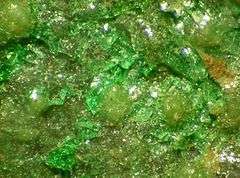Widgiemoolthalite
| Widgiemoolthalite | |
|---|---|
|
Widgiemoolthalite (bright green) intermingled with gaspeite (yellow-green). Field of view is 3 mm. | |
| General | |
| Category | Carbonate minerals |
| Formula (repeating unit) | Ni5(CO3)4(OH)2•4-5H2O |
| Strunz classification | 5.DA.05 |
| Dana classification | 16b.7.1.2 |
| Crystal system | Monoclinic |
| Crystal class |
Prismatic (2/m) (same H-M symbol) |
| Space group | P21/c |
| Unit cell |
a = 10.06, b = 8.75 c = 8.32 [Å]; β = 114.3°, Z = 2 |
| Identification | |
| Color | Bluish-green, grass-green |
| Crystal habit | Fibrous, rarely massive, pseudo-orthorhombic |
| Tenacity | Brittle |
| Mohs scale hardness | 3.5 |
| Luster | Silky |
| Streak | Pale bluish-green |
| Diaphaneity | Transparent |
| Specific gravity |
|
| Optical properties | Biaxial (+) |
| Refractive index |
nω = 1.630 nε = 1.640 |
| Birefringence | 0.010 |
| Pleochroism | None |
| 2V angle | High |
| Length fast/slow | Fast |
| References | [1][2] |
Widgiemoolthalite is a rare hydrated nickel(II) carbonate mineral with the chemical formula Ni5(CO3)4(OH)2•4-5H2O. Usually bluish-green in color, it is a brittle mineral formed during the weathering of nickel sulfide. Widgiemoolthalite was first discovered in 1992 in Widgiemooltha, Western Australia, to date its only known source.
Origins
Widgiemoolthalite was first found at 132 North, a nickel mine near Widgiemooltha, Western Australia. Blair J. Gartrell collected the holotype widgiemoolthalite specimen from a stockpile of secondary minerals at the site. The mineral was discovered in 1992 and was first reported in the American Mineralogist in 1993 by Ernest H. Nickel, Bruce W. Robinson, and William G. Mumme, when it received its name for its type locality.[1][3] Widgiemoolthalite's existence and name were approved by the Commission on New Minerals and Mineral Names of the International Mineralogical Association the same year. The holotype specimen was stored in Perth's Western Australian Museum.[1]
Occurrence
Widgiemoolthalite occurs as a secondary mineral. It is found overlaying nickel sulfide that has undergone weathering, often in hollow spaces on gaspeite surfaces, often exhibiting fibrous and rarely massive crystal habits.[1] Other minerals associated with widgiemoolthalite include annabergite, carrboydite, dolomite, glaukosphaerite, hydrohonessite, kambaldaite, magnesite, nepouite, nullaginite, olivenite, otwayite, paratacamite, pecoraite, reevesite, retgersite, and takovite.[1][4] Two additional unnamed minerals were also reported as associated secondary minerals from the 132 North site, the only locality at which widgiemoolthalite has been found.[2][4] The 132 North waste pile from which widgiemoolthalite was first recovered is no longer in existence, making it a rare mineral.[5]
Structure
Widgiemoolthalite is a nickel(II) carbonate that has undergone mineral hydration. Tests by Nickel, Robinson, and Mumme yielded the chemical formula (Ni,Mg)5.00(CO3)4.15-(OH)1.70•5.12H2O. The researchers observed that widgiemoolthalite is the nickel structural analog to the hydrated magnesium carbonate hydromagnesite and considering this relationship, determined that widgiemoolthalite's ideal makeup to be Ni5(CO3)4(OH)2•4-5H2O.[1] As of 2014, the exact crystal structure of widgiemoolthalite was not known.[5]
Crystals of widgiemoolthalite conform to a monoclinic system of symmetry, occupying space group P21/c. A unit cell of the mineral, the smallest divisible unit that possesses the same symmetry and properties, is composed of two of its molecules and has the dimensions a = 10.06, b = 8.75, and c = 8.32 Å. Each unit cell of widgiemoolthalite has a β value of 114.3° and a volume of 667.48 Å3.[3]
Characteristics
Hand specimens of widgiemoolthalite tend to be bluish-green though may also be grass-green in rare cases, while the mineral's streak is pale bluish-green. Widgiemoolthalite is transparent in hand sample with a silky luster. The mineral is brittle and breaks along its fiber contacts. Its observed specific gravity is 3.13 while its calculated specific gravity is 3.24, with a hardness of 3.5 on the Mohs scale.[1][2]
When viewed with polarized light under a petrographic microscope, widgiemoolthalite appears bluish-green and does not exhibit pleochroism. It is biaxial positive and has a high optic angle (or 2V). When measured perpendicular and parallel to its axis of anisotropy, its refractive indices are 1.630 and 1.640 respectively. This gives it a birefringence of 0.010.[1][2]
References
- 1 2 3 4 5 6 7 8 Nickel, E. H.; Robinson, B. W.; Mumme, W. G. (August 1993). "Widgiemoolthalite: The new Ni analogue of hydromagnesite from Western Australia" (PDF). American Mineralogist. 78 (7–8): 819–821.
- 1 2 3 4 "Widgiemoolthalite". Mindat.org. Hudson Institute of Mineralogy. May 1, 2016. Retrieved May 3, 2016.
- 1 2 Gamsjäger, H.; Bugajski, J.; Gajda, T.; Lemire, R. J.; Preis, W. (2005). Chemical Thermodynamics of Nickel. Amsterdam: Elsevier. p. 216. ISBN 0-444-51802-9.
- 1 2 Nickel, E. H.; Clout, J. F. M.; Gartrell, B. J. (July 1994). "Secondary nickel minerals from Widgiemooltha". Mineralogical Record. 25 (4): 283–291 – via ProQuest. (subscription required (help)).
- 1 2 Whitfield, P. S. (December 2014). "Diffraction studies from minerals to organics: lessons learned from materials analyses". Powder Diffraction. 29 (S1): S2–S7. doi:10.1017/S0885715614001146.

External links
-
 Media related to Widgiemoolthalite at Wikimedia Commons
Media related to Widgiemoolthalite at Wikimedia Commons
